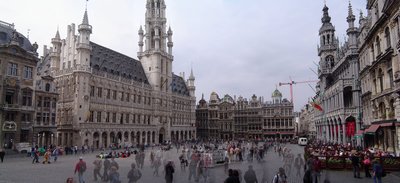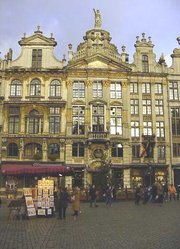Grand Place
|
|
The Grand Place (French: Grand-Place or Grand Place, Dutch: Grote Markt) is the central market square of Brussels. It is surrounded by guild houses, the city's spectacular town hall and the King's House (Dutch: Broodhuis, French: Maison du Roi). The market square is the most important tourist destination in Brussels.
The town hall was constructed between 1402 and 1455. The original architect was probably Jacob van Thienen. The gothic tower was designed by architect Jan van Ruysbroeck. At the top of the tower stands a statue of St. Michael, the patron of Brussels.
In the 13th century the predecessor of the King's House was a wooden building where the bakers sold their bread in a covered market: the Dutch name Broodhuis recalls this function. It was replaced in the 15th century by a stone building for the administration of the duke of Brabant; when the duchy fell to the Habsburgs, the Maison du duc became the Maison du Roi. In 1873, the city entrusted architect Victor Jamaer to restore the battered structure in neo-gothic style.
Hoteldeville_brussels.jpg
The Grand Place was first laid out after the construction of the town hall, at the centre of the city's commercial district. Neighboring streets still reflect the area's origins, named after the sellers of butter, cheese, herring, coal and so on. The original Grand Place was a medley of buildings constructed between the 15th and 17th centuries in a variety of styles.
On August 13, 1695, a 70,000-strong French army under Marshal François de Neufville, Duke of Villeroy attacked Brussels in retaliation for the League of Augsburg's attack on French-held Namur in what is now southern Belgium. The French launched a massive bombardment of the city centre with cannons and mortars, setting it on fire and flattening the majority of the Grand Place. Only the tower of the town hall and a few fragments of other buildings remained standing.
The square was rebuilt in the following four years by the city's guilds. Their efforts were regulated by the city councilors and the Governor of Brussels, who required that their plans be submitted to the authorities for their approval. This helped to deliver a remarkably harmonious layout for the rebuilt Grand Place, despite the ostensibly clashing combination of Gothic, Baroque and Louis XIV styles.
The Grand Place was named by UNESCO as a World Heritage Site in 1998. One of the houses was owned by the brewers' guild, and is now the home of a brewers' museum.
External links
- Brussels Grand Place in detail (http://www.rondement.be/)
- Unesco page related to the Grand-Place (http://whc.unesco.org/sites/857.htm)
- Virtual visit, photos and webcam of the Grand Place (http://www.ilotsacre.be/images/virtualvisit/grand_place-grote_markt.htm)
- Maison-du-roi (http://www.brussels-online.be/maison-du-roi/uk/)
fr:Grand-Place_de_Bruxelles it:Grand Place di Bruxelles nl:Grote_Markt_van_Brussel


